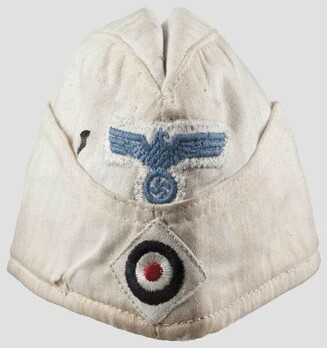Afrikakorps Kriegsmarine NCO/EM Ranks Board Cap
SKU: 23.GOR.01.03.02.002
Estimated market value:



Estimated market value:
Attributes
History
During the Second World War, German troops stationed in northern Africa are generally referred to as the Afrikakorps. Technically, this is not entirely correct, since some German units operating in Africa were not actually part of the DAK (Deutsches Afrikakorps), and some units of it were, in fact, Italian ones. However, for the purpose of collecting so-called “tropical” uniforms and insignia, collectors have simplified the meaning of the term.
The first German troops were sent to northern Africa in February of 1941, to support their Italian allies against the British. The climate of the African continent made it necessary to wear specialised uniforms and gear that not only supported the soldiers in serving in a hot and arid environment, but also helped them in blending in with the landscape, which, in general, presented itself as brown, olive, khaki, or sand/tan in colour. Worn over long periods of time under the blistering desert sun, some uniforms were eventually bleached to white or off-white. Uniforms and insignia in these colours are often referred to as “tropical”, and it is worth noting that they weren’t just worn by members of units stationed in Africa, but in the entire Mediterranean theatre of war, including southern France, Italy, the Balkans, and Greece, as well as in southern Russia during the summer months. Tropical uniforms were worn by members of all three branches of the Wehrmacht: the Heer (army), the Kriegsmarine (navy), and the Luftwaffe (air force). Members of the Waffen-SS stationed in southerly regions also wore tropical-style uniforms, and even though they technically have no connection to the DAK, all tropical uniforms and insignia of all branches of the German military are listed here.
In 1938, the precursor of the Board Cap was introduced as the Battle Cap (Gefechtsmütze). It was meant to be worn as a practical, everyday cap. This first model was limited to wear to Officers within the Line Officer career, or to Non-Commissioned Officers (NCOs) and Enlisted Men (EMs) when they were actively serving in war/battle duties. The regulations were altered in March 1939, to allow for Kriegsmarine crews serving on training vessels to wear the cap as well.
On October 7, 1939, the cap was re-instituted as the Board Cap (Bordmütze). The Board Cap was permitted for wear and duty while on and off the ship and was broadly worn by all Kriegsmarine personnel. This second model of the cap only underwent slight design changes from the first model; the internal top stiffener was removed.
By November 1939, the white Board Cap for personnel who were serving in warm, tropical climates had been introduced.
The interior lining of the caps for Officers and Officials was made from rayon (artificial silk), while the lining for Non-Commissioned Officers and other ranks was made from gray twill cloth.
Each cap was adorned with at least two official insignia, including a tricolour cockade on the front flap and a national emblem above it, along the centre seam, both on white cloth backings. The light blue national emblem was composed of machine woven thread for NCOs and EMs, or hand embroidered bullion wire or celleon for Officers.
Unofficial insignia, known as tradition badges (Erinnerungsabzeichen), were also worn on these caps. Due to the unauthorized nature of these badges, there are hundreds of known variations. The badges were associated with Armed Forces units, and while regulations prohibited their use, the badges were often allowed for wear on-board ships because they fostered comradery between personnel.
The Board Cap worn by Officers and Officials was made from a high quality doeskin. From July 1940 onward, a Gewebelitze (cord piping) was placed along the top of the side skirts. The piping is gold-coloured for Officers, high ranking musical personnel, Administrative Officials who held the rank of Admiral, and Senior Officer Candidates, and silver-coloured for Administrative Officials who held the rank of Officer. This cap was not a mandatory part of the uniform for Admirals.
The Board Cap worn by NCOs and EMs is identical to the cap worn by the higher ranks, except that it lacks the lining and the piping along the side skirt.
This cap is also known as the M1939, the Schiffchenmütze, or the Overseas Cap.


Comments
Sign in to comment and reply.


Scroll Top